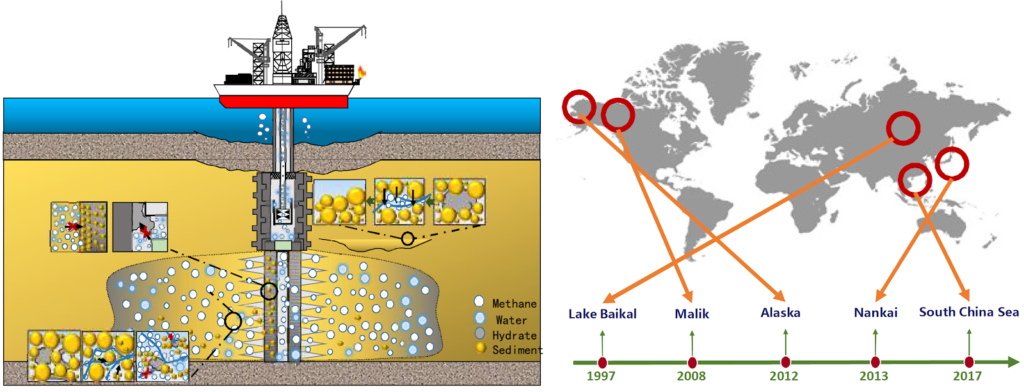Methane hydrate and geothermal are clean unconventional energy resources, which will replace traditional fossil fuel like coal, natural gas, and oil.
Methane hydrate is an ice that contains methane gas inside, and it is found in offshore soil where one could also find conventional oil and gas. If methane gas can be released from the ice without disturbing the surrounding soil, it could be produced as natural gas and used as an energy resource. Methane hydrate is often found in nations with poor energy resources such as Japan, and thus the development of methane hydrate could help such nations to be more energy-independent. The main objectives of this project are (1) to reveal the mechanism of sand production, (2) to estimate the long-term methane gas production potential and geomechanical behaviors of methane hydrate reservoirs, and (3) to investigate the wellbore integrity during methane gas production. Commercial finite element software such as ABAQUS and COMSOL are employed to conduct the numerical simulation. Laboratory experiment utilizing a high-pressure soil chamber is also carried out to look into the sand production phenomena. This project is funded by Japan Oil, Gas, and Metals National Corporation (JOGMEC).

Geothermal energy is generated and stored in the earth, which requires an understanding of deep underground. The motivation for geothermal energy research is to advance understanding of the impacts of the urban underground on a subsurface temperature increase at the city-scale. This research is driven by the recently emerging data on the impacts of underground basements and tunnels on subsurface temperature. The data indicate that the magnitude of anthropogenic heat fluxes into urban groundwater is increasing and its quality and natural flow are changing. In tunnels and stations, the thermal discomfort due to the temperature rise also highlights the lack of reliable ground temperature data for efficient underground development, including the design of efficient ventilation systems. The ambition of this project is to develop a framework for predicting temperature and groundwater maps at high resolutions in the presence of underground heat sources and sinks. This can be achieved via a combination of numerical modeling, continuous temperature and groundwater monitoring, and statistical analysis.
